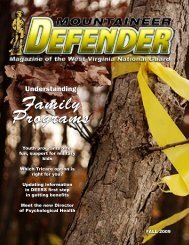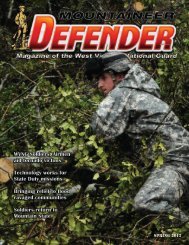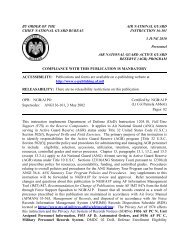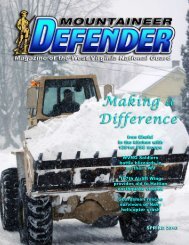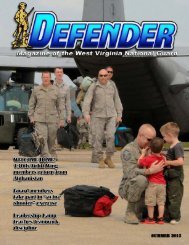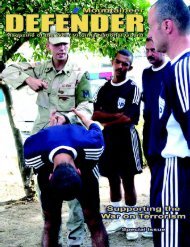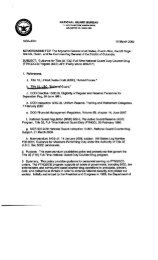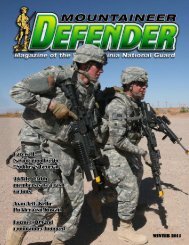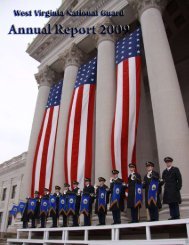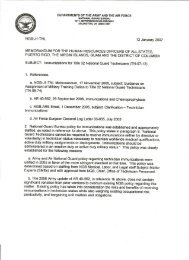2008 Annual Report - West Virginia Army National Guard - U.S. Army
2008 Annual Report - West Virginia Army National Guard - U.S. Army
2008 Annual Report - West Virginia Army National Guard - U.S. Army
You also want an ePaper? Increase the reach of your titles
YUMPU automatically turns print PDFs into web optimized ePapers that Google loves.
<strong>West</strong> <strong>Virginia</strong> <strong>National</strong> <strong>Guard</strong> <strong>Annual</strong> <strong>Report</strong> <strong>2008</strong><br />
1 st Battalion, 201 st Field Artillery<br />
The 1st Battalion, 201st Field<br />
Artillery, established on Feb. 17,<br />
1735, is known as the oldest continuous<br />
service unit in the <strong>Army</strong> – the 1st<br />
<strong>West</strong> <strong>Virginia</strong>. During Fiscal Year<br />
<strong>2008</strong> the Battalion focused on platoon<br />
level proficiency required by the <strong>Army</strong><br />
Force Generation (ARFORGEN) training<br />
model to incrementally prepare the<br />
unit for re-deployment. In addition, the<br />
201st serves as the <strong>National</strong> <strong>Guard</strong> Reaction<br />
Force (NGRF) for <strong>West</strong> <strong>Virginia</strong><br />
and the Washington, D.C. area.<br />
This year’s training resulted in significant<br />
improvements with Paladin gunnery during<br />
the live-fire exercise and annual training at<br />
Fort Pickett, Va. During the live-fire exercise in<br />
March the unit live-fire<br />
certified 15 Paladin<br />
Howitzer sections, and<br />
during <strong>Annual</strong> Training<br />
in May, the unit<br />
live-fire certified 4<br />
Paladin platoons.<br />
Also during<br />
annual training<br />
the 201st conducted<br />
realistic training lanes<br />
emulating the current<br />
operating environments in Iraq and Afghanistan.<br />
Soldiers experienced several<br />
scenarios that included<br />
groups of agitated civilians<br />
and IED attacks on<br />
convoys. Soldiers were<br />
trained on proper convoy<br />
security procedures using<br />
the Vehicle Convoy Operations<br />
Trainer (VCOT) and<br />
transitioned from there to<br />
the convoy live-fire range.<br />
capability sets<br />
and completed<br />
a NLW certification<br />
course at<br />
Camp Dawson,<br />
W.Va. During<br />
the five-day<br />
certification<br />
course each<br />
NGRF soldiers<br />
completed 80<br />
hours of training<br />
related to non-lethal weapons. The course<br />
covered kinetic non-lethal weapons, riot control<br />
agents, riot control formations, vehicle and vessel<br />
stoppers, rules of engagement, rules for use<br />
of force, and emerging technologies. Each soldier<br />
was required to demonstrate proficiency using<br />
pepper spray, riot batons, the<br />
TASER, and defensive tactics<br />
in order to receive certification<br />
through Penn State University,<br />
The Eberly Campus’ Center for<br />
Community and Public Safety<br />
(CCPS).<br />
The 1201st Forward Support<br />
Company (FSC) continued<br />
its transition to a modular support<br />
company. During annual<br />
training the FSC established its<br />
first field ammunition transfer point used for the<br />
distribution of<br />
howitzer ammunition.<br />
The FSC<br />
also fielded a<br />
new fuel tanker<br />
system designed<br />
to improve fuel<br />
distribution support<br />
capability.<br />
In January <strong>2008</strong> the<br />
battalion’s NGRF fielded<br />
non-lethal weapons (NLW)<br />
46




